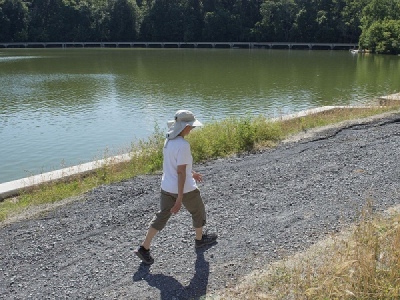
Posted on June 22, 2017
By Danielle E. Gaines, The Frederick News-Post
Hundreds of dump trucks of sediment that’s been accumulating at the bottom of Lake Linganore for the last 45 years will be dredged up and used to help county landfill operations as part of a multi-year project that’s set to begin the construction phase soon.
The Frederick County government is taking the lead in a multi-party plan to remove up to 350,000 cubic yards of sediment from the upper reaches of the 209-acre man-made lake, which serves as a primary source of drinking water for the city of Frederick.
As the $15 million project moves toward the construction phase, county officials provided an update on the process Tuesday morning.
“All the agencies have signed off on it. We’re just waiting for the final, actual permits,” said Mike Marschner, special projects manager in the county executive’s office.
The process to accept bids for the work and select a contractor is set to take place next month, with the Maryland Environmental Service helping with the process, Marschner said.
A plan for dredging has been in the works for years.
“Discussions about dredging have been ongoing for a number of years,” County Executive Jan Gardner (D) said. “I would say, at least 10 years.”
In 2006, when she was on the Board of County Commissioners, the county approved a Linganore watershed action plan to limit sediment and nutrient pollution in the lake.
The current project was officially launched in 2014, when the county, city and Lake Linganore Association — the homeowners association for the neighborhoods built around the lake — signed a three-party agreement to remove sediment from portions of the lake upstream from Boyers Mill Road.
The project is expected to cost slightly more than $15 million, with $14.4 million in construction costs and about $700,000 for other costs such as planning, permitting and oversight, Marschner said.
Half of the total cost is being paid by the city of Frederick, with Frederick County and the Lake Linganore Association contributing 25 percent each.
The county government is chief coordinator because of its experience with large projects.
In Phase 1 of the project, the county evaluated engineering options, looked at possible places to store the dredged sediment and applied for the necessary permits.
The construction and restoration phase is expected to take up to 2½ years, Marschner said.
The project will use a “hydraulic dredging” process, which is less disruptive than other options such as “clamshell bucket dredging,” which stirs up sediment and increases turbidity in the water, Marschner said.
During the dredging, the lake will remain suitable for aquatic life and as a source of drinking water, he said. Recreational activities will be able to continue outside of the immediate areas where work is being done.
Because the process will cause some noise, officials have been meeting with nearby residents and will limit work to certain hours.
Once broken up and sucked from the bottom of the lake, the sediment deposits will be taken to a “dewatering” staging area off an access road near the Hamptons neighborhood.
Once dried and settled, the sediment will be hauled to the county’s Reichs Ford Road Sanitary Landfill. The sediment will be stored and used as cover soil for regular landfill operations, relieving the county from buying cover soil elsewhere, Marschner said.
Chemical analyses of sediment samples showed profiles similar to regular soil levels and have not revealed any health concerns, Marschner said.
Trucks hauling the sediment away will use an access road off Gas House Pike.
Besides being the primary source of water for the city of Frederick, Lake Linganore serves as an emergency backup source for the county, which primarily draws from the Potomac River.
The lake was constructed in 1972, primarily to serve as a recreational lake.
The unwanted sediment is up to 8 feet deep in spots and has decreased the lake’s capacity up to 65 percent in some places.
Gardner said the project will, in some cases, improve access to the water for nearby homeowners, but more importantly, increases the city’s drinking water storage capacity.
“When you turn on your tap or your shower, you expect clean and abundant water to come out,” she said.
Source: The Frederick News-Post





